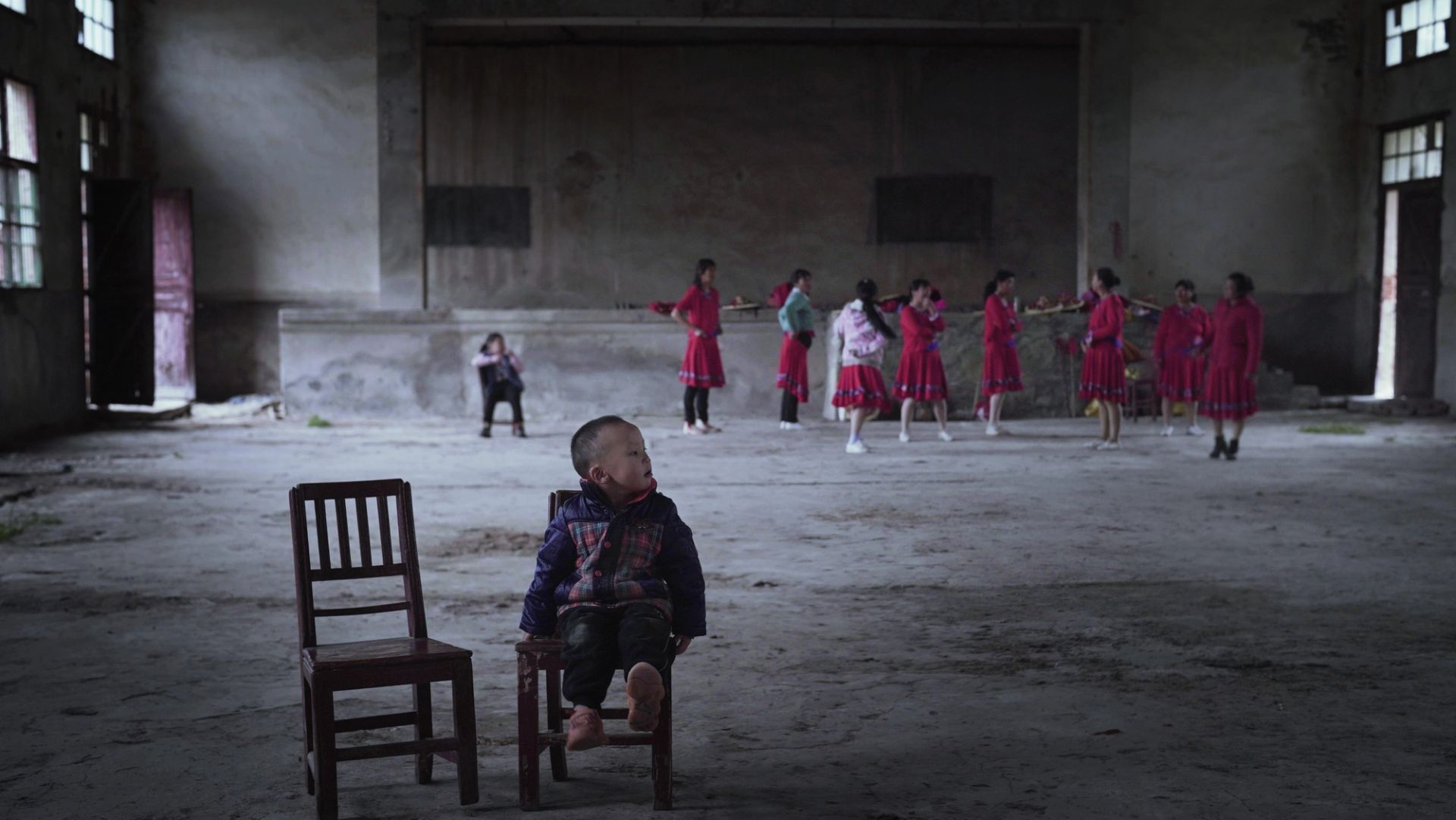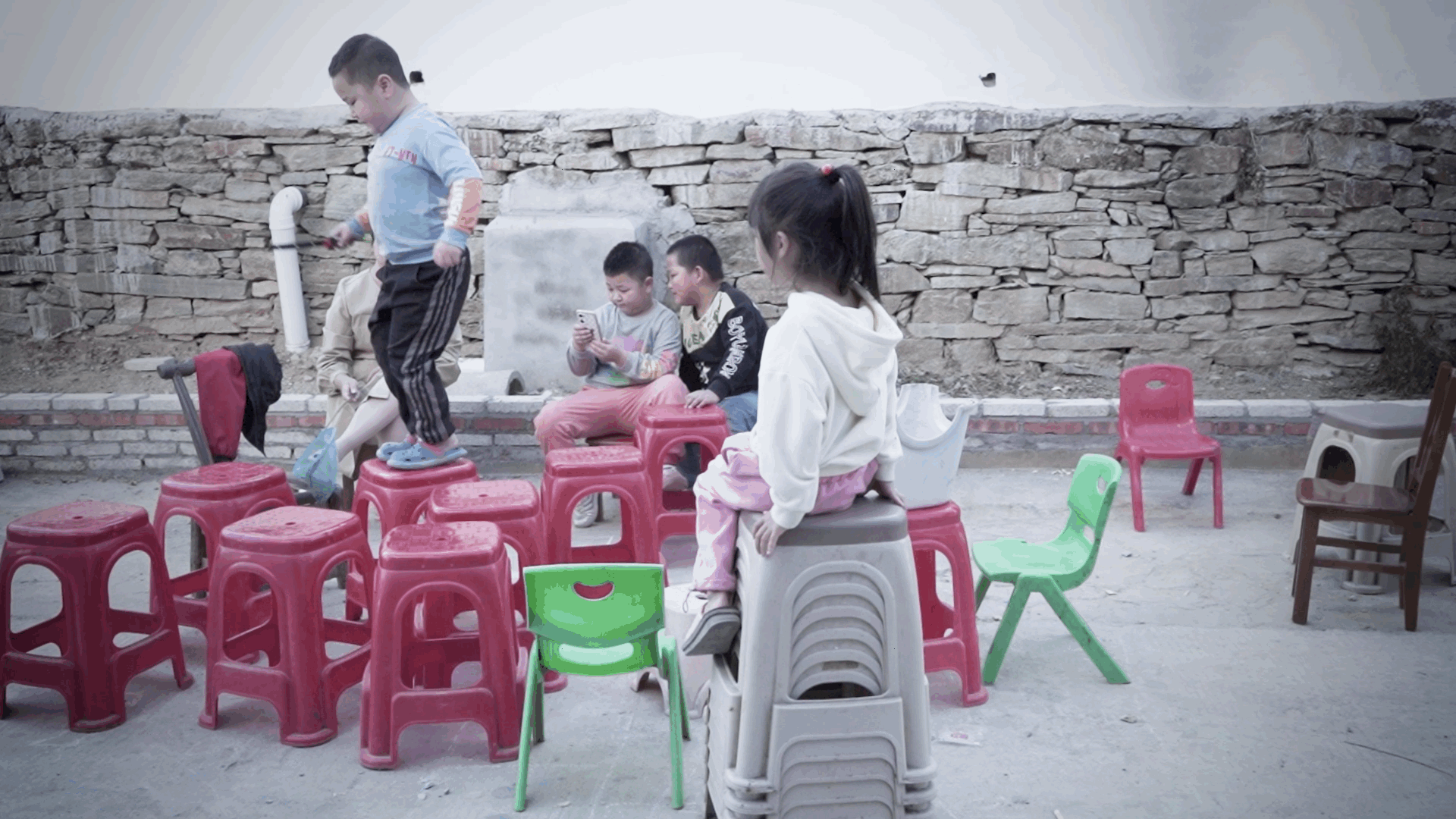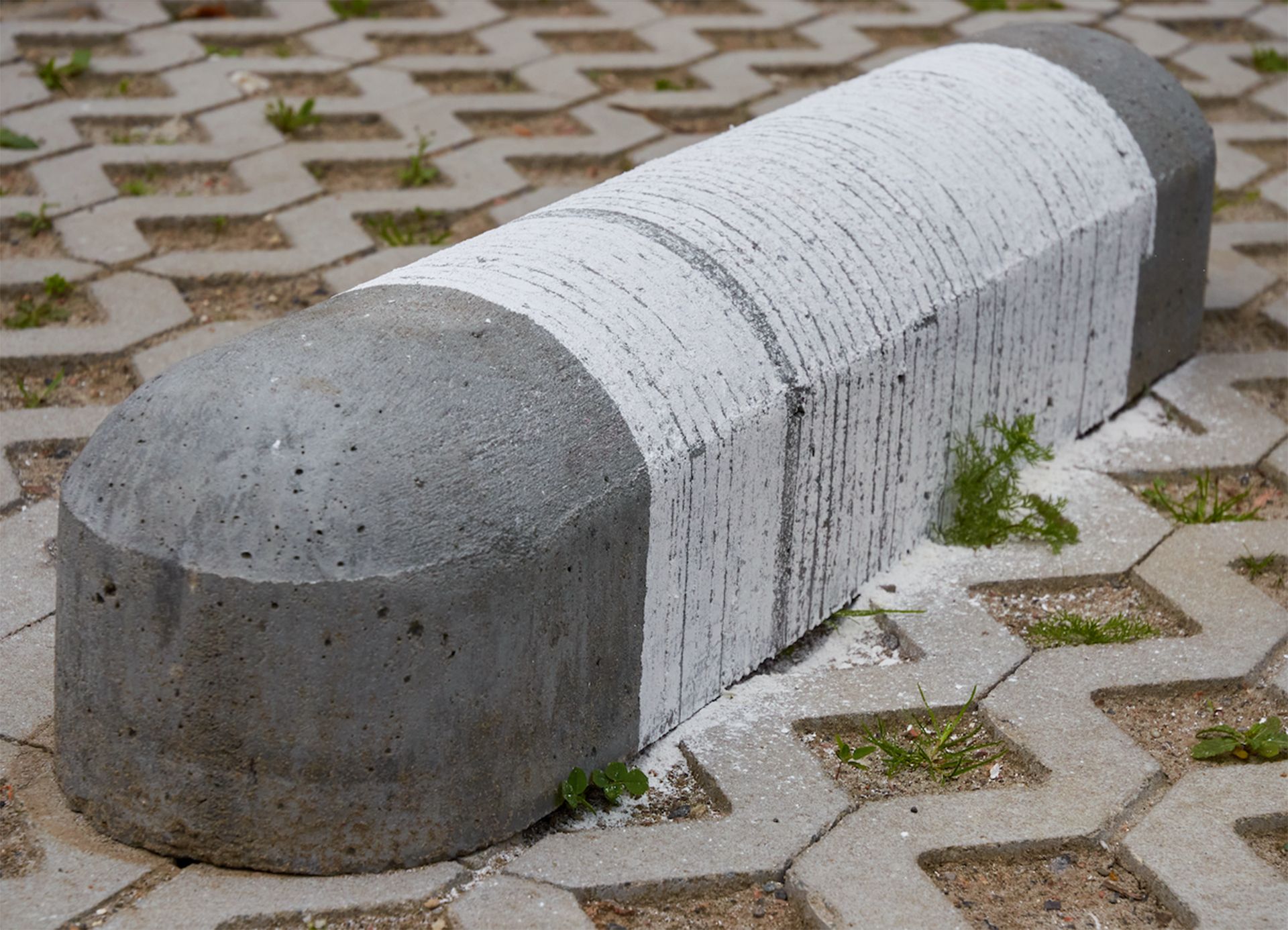A rectangle is chalked on the dusty ground in front of the village convenience store. A boy lies down to fit himself in it, rolling around as though he were lying on a soft, comfy bed. He later fills a square in the corner with dense blue. He said it is the sea, one in the furthermost place.
A granny likes to sing. She sings her way around the village. Her walking stick is sometimes a paddle and sometimes a chisel, depending on where her songs take her in places and times.
A group of aunties dances on the village street every day after dinner. Occasionally, cars and goats pass. Unphased, the aunties dance around them.

Group dance improvisation with children playing around in the abandoned People’s Commune Assembly Hall, a scenario in RIPPLE RIPPLE RIPPLING; photographed by Chen Zhan
These are some recent moments in the daily life of Shigushan village. Shigushan sits on the outskirts of Wuhan and was once a model settlement of the People’s Commune during China’s national collectivisation (1950s - 80s). The villagers have generously let me into their lives over the years, starting from a piece of watermelon on a hot summer day in 2015. This relationship has gradually evolved into a collaborative project, RIPPLE RIPPLE RIPPLING, in which I have been joined by Chen Zhan, an architect, anthropologist and independent filmmaker, and Mengfan Wang, a choreographer and theatre director.1 As I write this column, Chen and Mengfan are living with the community in Shigushan. The daily activities are improvising, together with the villagers, slightly odd scenarios, in which playing, singing and dancing take place.

Solo dance improvisation in the abandoned People’s Commune Assembly Hall, a scenario in RIPPLE RIPPLE RIPPLING; photographed by Chen Zhan
With improvisation, we hope to stimulate the villagers’ own performative expressions, story-telling and imaginations that are otherwise hidden. This is the other side of Speculative Anthropology: joining with marginalised communities in their situated perspectives and embodied vision.
Feeling odd or weird is the delicate, ambiguous state we are trying to co-curate. Oscillating between the familiar and the strange, it is one step out of reality but not yet into fiction. With improvisation, we hope to stimulate the villagers’ own performative expressions, story-telling and imaginations that are otherwise hidden. This is the other side of Speculative Anthropology: joining with marginalised communities in their situated perspectives and embodied vision. At least, if done with care and sensitivity, it is an act of solidarity. At most, such alliances constitute political subjects of knowledge - “knowledge potent for constructing worlds less organised by axes of domination.”2 Then, how so, and why?

Children’s game with chairs, a scenario in RIPPLE RIPPLE RIPPLING; filmed by Chen Zhan
Villagers in Shigushan are among the hundreds of millions of rural families in China today who have seen the absence of the middle generation. Grandparents and young children are left behind in the village, economically dependent on the middle generation (largely men) working in the city - who are themselves known as the floating population.3 The dissolution of families is a survival tactic that contests the hegemony of the essentialised model of the modern nuclear family and its associated domesticity.What has emerged is an intergenerational, interdependent way of living - that is, a ripple effect of domesticity.4
These rural families do not just endure precarious circumstances imposed on them by the agents of power and that are well beyond their control; they own precarity.
Crucially, dissolving the family is a temporary, transient state that has become part of a broader structure rather than an exception. To put it differently, these rural families do not just endure precarious circumstances imposed on them by the agents of power and that are well beyond their control; they own precarity. These families form indeterminate and resilient assemblages - at the edge of the capitalist apparatus, both within and outside - that are spatially stretched from house to territory and temporally coordinated from daily to multi-year cycles.
I find it profound - a way of life that seems to settle in liminality. So I want to know more about it and feel more about it. It is important to note that, in our approach, these rural families are not sources of “qualitative data” for subsequent interpretation (this is the classic anthropological method). They are also not abstract research subjects whose diverse experiences are often too easily reduced to either victim or hero narratives.5 They are just real people we are trying to connect with.
What underpins their way of life can be understood as situated knowledge. Dispersed and circulated as part of everyday practices on the margins, situated knowledge is highly contextual, largely non-discursive, and bodily - in other words, almost in the form of disposition. An example of this in village life is what we call “active waiting”, manifested through sitting on and around spatial thresholds - that could be in the yard, at the front gate or in front of the convenience store. To an outsider, the sitting villagers may appear to be doing nothing. But, by pushing their own bodies to inhabit thresholds, these villagers are actively building up an elastic field of support and a sense of relatedness between themselves. This active waiting on a collective scale is fundamental to forming assemblages of social and economic security that hinge on inter-generational and cross-household dependency, at a time when state welfare is insufficient and core family members are absent. If the modern mind finds waiting as a way of life inconceivable, this might be a lack of experience or imagination of the intensity of social bonds present in these assemblages.
With the margin considered not just economically but also culturally and intellectually underdeveloped, situated knowledge is diminished and overlooked by the paternalistic model of “expert" leadership.
To flourish situated knowledge rooted in precarity, the challenges are acute. With the margin considered not just economically but also culturally and intellectually underdeveloped, situated knowledge is diminished and overlooked by the paternalistic model of “expert" leadership. Also, how to articulate a form of knowledge that resists representation and crystallisation? Moreover, the dominant culture is rather blind to actions with no lexical declarations, struggles with no overt conflicts, and stories with no hero or heroine. With little currency in the new or the radical or striking visual evidence, how to carve out a space for its distribution?

Architectural reconstruction of filmic space and time, film clip from ON THE MARGINS, 2022, dir. Jingru (Cyan) Cheng and Chen Zhan
To disappoint some, I do not have any clear answers - not yet. This is what Chen, Mengfan and I are trying to figure out through the ongoing RIPPLE project. This is probably an anticlimactic way to end this column series; but, perhaps, in the spirit of precarity, it is fitting.
Read the entire "Living with Precarity" column by Jingru (Cyan) Cheng.
Bio
Jingru (Cyan) Cheng is a transdisciplinary design researcher. At the intersection of architecture, anthropology, performance and filmmaking, Cyan’s collaborative work is committed to generating new sensibilities and imaginaries. The wide-ranging themes include non-canonical frameworks of being, knowing and practising, aesthetic agency, and modes of co-existence between human and more-than-human. Cyan received commendations by the RIBA President’s Awards for Research in 2018 and 2020 from the Royal Institute of British Architects. Her work has been exhibited at Critical Zones: Observatories for Earthly Politics (2020-22), Driving the Human: 21 Visions for Eco-social Renewal (2021), Seoul Biennale of Architecture and Urbanism (2019), Venice Architecture Biennale (2018), among others, and included in the Architectural Association’s permanent collection. Cyan holds a PhD by Design from the Architectural Association (AA), and was the co-director of AA Wuhan Visiting School (2015-17). She currently teaches at the Royal College of Art (RCA) in London.
Notes
1 The current phase of the project is generously supported by the Graham Foundation for Advanced Studies in the Fine Arts. For more information, please visit the project website: https://rrr.network/
2 This point is informed by feminist politics and epistemologies of location, positioning and situating. The phrase is quoted from Donna Haraway, “Situated Knowledges: The Science Question in Feminism and the Privilege of Partial Perspective,” Feminist Studies 14, no. 3 (Autumn, 1988): 575-599. A recent important addition is Rosi Braidotti, Posthuman Feminism (Cambridge, UK: Polity, 2022).
3 The “floating” status refers to the back-and-forth movement of these rural migrant workers between workplaces in the city and a home village in the countryside. Demographic studies have suggested that it is only partially due to their limited rights to employment, housing, and social welfare in cities; they are also partially motivated by a desire to live this way.
4 For a more academic account on the ripple effect of domesticity, please see Jingru (Cyan) Cheng, “Rippling: Towards Untamed Domesticity,” The Journal of Architecture (2022).
5 On this point, I have learnt a great deal from email exchanges with AM Kanngieser. Also, for more on the ethics of working with marginalised communities, please see Eve Tuck, “Suspending damage: A letter to communities,” Harvard Educational Review 79, no.3 (2009): 409–27.
Bibliography
Braidotti, Rosi. Posthuman Feminism. Cambridge, UK: Polity, 2022.
Haraway, Donna. “Situated Knowledges: The Science Question in Feminism and the Privilege of Partial Perspective.” Feminist Studies 14, no. 3 (Autumn, 1988): 575-599.
Tuck, Eve. “Suspending damage: A letter to communities”. Harvard Educational Review 79, no.3 (2009): 409–27.




